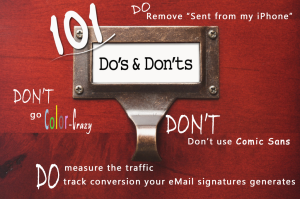Your Email Signature – 101 Do’s and Don’ts. Part 1 – The Do’s
As you can probably imagine, we have heard thousands (if not tens of thousands) of great stories regarding how different companies set up their email signature templates, or at least attempt to.
Over the last few months, we’ve begun collecting examples of the do’s and don’ts that we’ve discussed and learned from our Xink customers, prospects and partners. Many of the items in this list are self explanatory, but for the uninitiated, we’ve also taken the time to provide a little bit more color on topics presented.
Let’s start with the positive. Here are a more than a handful of suggestions and best practices when it comes to creating your email signature format, then things you should definitely DO.
There are many reasons to choose Xink as your email signature management solution. From brand consistency and compliance, all the way to creating a new marketing channel for quality traffic and conversions, there’s tremendous upside to leveraging your company’s most widely used communication method (email) to drive marketing value.
1. Get an email signature
This shouldn’t come as a surprise. This blog is filled with examples of why, regardless of your industry or company size, you should use the email signature block consistently.
2. Get an email signature – even if you’re in IT
We’ve had 100’s of conversations where we learn that the IT department chooses to boycott any email signatures in their emails. Many go a step further to only send out emails only in plain text format. The email signature is an important marketing lever – pull accordingly.
3. Give your email signature format some style
Your email signature format should not just be comprised of the obligatory name and phone number. It’s a great opportunity to share contact details, marketing messages, latest tweet or blog post.
4. Add your company logo to your email signature
This is a really common discussion topic. The days are long over when it was considered dangerous to add graphical content to your email signature templates. Modern email programs can actually handle this quite well.
It’s ok to add logos to email signatures!
5. Give your email signature format as much thought as a marketing campaign
Just as you do with your marketing campaigns, ask yourself who are you targeting with your email signatures (this might point out that you need more than 1 template for your organization), what’ the behavior you want to drive (CTAs) and how are you going to measure results (do you need a landing page, are you setting up UTMs to track traffic?), etc.
6. Follow company brand standards
If your company has a brand style guide and doesn’t have a standard email signature for the company – that’s problem. Email signatures can easily be designed to fit even the most stringent brand guidelines.
7. Don’t stop at the contact details; market to your contacts with campaigns
Email deliverability rates for mass marketing email is on the decline. One of the most efficient routes to the inbox of your customers, prospects and partners is via peer-to-peer email, the email we send every day.
Choose an email signature management solution that allows you to create and manage email signature campaigns, while at the same time measuring them for success.
 When it comes to designing email signatures, there are a lot of things to remember.
When it comes to designing email signatures, there are a lot of things to remember.
8. Start with HTML to Design Your Signature
Have a web designer take your existing email signature template and mark it down in HTML (note: there’s several entries in this blog post on how far to take HTML coding for signatures…hint: not far). HTML will give you the flexibility to create great looking signatures, in a highly portable format that you can apply just about anywhere, given the right email signature management tool.
9. Try to use TABLE tags
We always recommend you the use of html tables when you generate your email signature content. The reason for this is that you have a great control over the visual layout, you can optimize the signature towards mobile readers if you wish and the tables are scalable and are good as content generators. Always use tables if you can.
10. Always add HEIGHT and WIDTH to your images
If you don’t add a height and width to your images in your email signature they might get resized by the email program used by the recipient. This is the #1 cause of the dreaded “my email signature doesn’t look right” complaint from your end users.
11. Find a decent balance between text and image size in your email signature
This is really a design discussion… We have seen signatures with a clear disproportion between graphics and text/content. Make sure that you have a properly designed email signature which looks professional, while considering the sizes of logos and promotional banners, so that they fit the overall design.
12. Use inline CSS, but…
Inline CSS is understood and rendered correctly by most email programs. It goes against what you’d assume in today’s computing environments, but old-school HTML is the better format. But…
13. Make the HTML as robust as possible
You can skip the HTML5 code for now, email readers don’t know what to do with it. Make your HTML as solid as possible. Need examples? Ask us.
14. Consider how it looks in mobile devices
Carefully consider your email signature design with respect for mobile devices. A good rule of thumb is using your logo as the horizontal anchor, setting it at 300px (max 320px) width. As long as your contact details don’t go beyond your logo, you should be in good shape.
15. Try keep the signature below 650 pixels, vertically
Mobile, screen vertical should be below 650 pixels. Same considerations as above.
16. Make sure contact details are up to date
It’s incredibly important that your email signature template contains up-to-date contact details. You’d be surprised how often phone numbers and systems change, offices change locations, etc. Our customers avoid the embarrassment and cost of change of this type of information by hooking Xink up with their Active Directory deployment for a consistent, accurate source of information for signatures.
17. Add Twitter icon to increase your follower base
You’d be surprised how many organizations don’t do this; the email signature is a great way to grow your social networks.
18. Use a different email signature for your replies and forwards
There is probably nothing more frustrating than being looped into an email thread, only to find that 90% of the thread is email signatures and their email disclaimers. Xink allows you to specific a different signature for replies and forwards, which gives you the option of cutting down on valuable real estate for those important emails.
19. Add your latest content marketing content to your email signature
Use your email signature to extend the life of your content marketing assets. This is a great strategy especially for ‘paid-for’ content – each new conversion brings down the overall cost of that item over time.
20. Let your IT guys help, to a limit
It’s great to get IT involved, but we’ve found that once the system is up and running, it’s best if Marketing is left to control and manage signature and campaign content.
21. Nominate someone from Marketing be responsible for the content
See above
22. Comply with the law
For many organizations, the email disclaimer statement(s) at the end of their email signatures is an absolute requirement. Be it for regulatory, legal or even transnational trade requirements, these email disclaimers are a key part of staying on the right hand side of the law.
Automate these email disclaimers in the same way you automate the placement of your email signatures.
If you’re unsure about how to properly implement email disclaimers, contact us and we can help advise which rules might apply to you.
23. Add an image of yourself to the email signature
A very popular choice of national real estate, insurance and legal entities. Just as you shouldn’t fear putting in a jpeg of your company logo, your picture shouldn’t be off limits either. Go get a nice haircut and show it off!
24. Be consistent, across every device
Make sure your device not only renders well across all devices, but that you can send your company standard signatures from all of your computing devices.
25. Use the OWA app for your iOs/iPhone or Android device if you have Office 365
It’s the easiest way to ensure you get your company signature, consistently, every time.
26. Always create a plain text signature alternative
If you receive an email in Plain Text, Outlook will respond in kind (the same applies for rich text). If not supplied ahead of time, Outlook thinks its doing you a favor and creates the signature in these formats itself with a horrible result. Do it yourself and ensure your brand is represented correct.
27. Create a Rich Text signature also, but…
They aren’t used too much anymore, an outlier being Outlook meeting invitations, which are in rtf format.
28. Add a decent color scheme to your email signature design
Consider the use of colors in your email signature. Don’t use dramatic or aggressive colors, always making sure to comply with company standards, but no one says it has to be a standard black font color.
 29. Add LinkedIn…but whose?
29. Add LinkedIn…but whose?
Similar to the previous, with a small wrinkle. One thing we’ve seen to be very prevalent with customers in the technology space is that sales people at tech companies prefer their LinkedIn page to link in their signature block as opposed to the company LinkedIn page.
Which way is preferred? It’s really up to the company, the more important aspect is that your email signature solution allows you to provide that option to your employees.
30. Measure the traffic you get from your email signatures
I can’t believe we put this at #30, as important as this is! The exercise of developing, implementing and managing email signatures and campaigns is a waste of time if you’re not measuring the outcomes.
This is especially true for email signature campaigns –the promotional marketing campaigns promoting new products and services, event sponsorships, even awards you’ve won!
Measuring the positive impact of campaigns is key to identify potential new sources of traffic and conversions. Xink offers native analytics, as well as seamless integrations with 3rd party analytics packages such as Google Analytics, Ominiture, Webtrends, among others.
31. Ensure your signatures are consistent across Outlook and OWA
A key to establishing any brand is consistency. An important aspect of this is now your email signature is presented, regardless of your computing device. One thing you definitely want to make sure of is that your email signature is delivered consistently, regardless of the device you use to create your email.
32. Remove “Sent from my iPhone”
No one cares. Same goes for other vendor messages.
33. Get an expert to help to code your email signature
If you don’t have a designer on staff –let us help you. Your signature is too important to get it “almost right”. We’re happy to help.
34. Spam filter test your signature before using it
You’d be surprised how often a horribly configured/designed email signature adds to an email’s spam score. MailChimp has a great primer here on the things that spam filters hate (or like, depending on your outlook of things).
35. Always use the ALT tag when adding an image to your signature
This is a great backup if your recipient is filtering images.
36. Target email signature campaign content to recipients
We’re obviously a big believer that email signatures should be used to run marketing campaigns, in addition to enforcing brands. However, you should take the same approach you do with any marketing campaign – consider your audience. For example:
Support team members – a link to the KB might save the occasional support ticket here and there.
Finance – driving recipients to your AP or AR pages could speed up payments
HR – a link to your open jobs page can net a great candidate
See, it’s not just about product leads and sales – every group in the company can leverage signatures to create more qualified engagement with their respective audiences.
37. Provide employees with signature options to choose from
We’ve been pretty consistent here about preaching consistency, but one thing to consider is providing options for your end users, in terms of signature templates. Xink makes it easy to provide multiple email signatures to your users.
Operationally, many of our customers also specify an “internal-only” signature, which pares down the contact info of signatures, to minimize the clutter of multi-response threads.
A unique example is also law firms – one of our law firm customers provides an internal-only signature which contains legal staff’s internal 5 digit extension, as well as their billing code, which comes in handy when collaborating with other attorneys via email.
38. Consider other geographies
If you do considerable amounts of business in other countries and languages, it makes sense to support those with localized signatures.
39. Make the email signature a mandatory part of your email.
It sounds somewhat draconian, but the benefits far outweigh the drawbacks. Plus, I have kids to feed – so, come on.
40. Style tip: Color code your URL links
This keeps your visited links from changing color, which could appear to be a design oversight on your part.
41. Add images to your email signature only in 100% size.
Don’t scale a logo which is 500KB to a width of 4%. Scale the logo to match a 100% signature size. Otherwise, email readers might scale it for you and that could create a nightmare signature appearance.
42. Don’t have your reply signature take up the whole screen
Create a separate signature for reply and forwarded emails, with pared down information. Your recipients will thank you.
43. Add only your disclaimer once and in the right place
Don’t stack them and consider the actual relevance of them.
44. Add your registered company details and VAT number into the email signature
European companies, take note. This isn’t a ‘nice to have’, it’s the law. Automate this wherever possible.
45. Make sure your links in your email signature are not dead.
Common sense, of course, but there is no greater buzzkill than arriving at a 404 page.
46. Integrate analytics into your email signature clicks and statistics
This goes along with measuring your positive outcomes. If you are using an analytics package, definitely integrate it with your email signature management solution.
47. Provide a vCard link
vCards are cross-platform and always work. Great way of getting a recipient to add your contact details into a vCard.
48. Always use html as your email format and create the email signature as html
HTML is no longer an area of concern with regards to email signature formatting and development. It’s great to be able to specific a plain-text alternative email signature
49. Where possible, make email signatures read-only
I can’t tell you how many inflated titles I’ve seen when it comes to employees spinning their own signatures. If you must, use an email signature management solution that allows for users to only edit pre-approved items.
50. Make the signature apply another color other than the standard blue reply font
This can happen if the signature is not properly coded and just generally looks unpolished.
51. Have a clear Call-to-action in your email signature marketing message
This is Marketing 101. Consider your audience and use your email signature to drive a behavior. Examples include:
– Joining your social network
– Visiting your blog or knowledge-base
– Attending your conference
52. Apply your whole corporate identity through your email signatures
If you apply sub-brand or department level corporate ID, carry that through to your email signatures as well.
53. Use your internal email signature to promote internal company information
If your intranet doesn’t get the traffic it used to, then use your email signatures as a means for promoting internal company information.
54. Promote your industry awards
Get your company the credit and awareness it deserves. It’s a great credibility booster with your recipients.
55. It’s ok to use the expensive font that a design agency made for just for you
If you have paid a million dollars for a design agency to make design your own company font, you can use this in your email signature without problems.
The only thing is that it will display correctly inside your company, but not externally because the font will most likely not be installed on the recipient’s computers. Instead, make sure that you define an alternative font in case that the default font does not exist on the computer. Also test this and make sure that the signature still looks nice with another font.
Originally published on Xink









